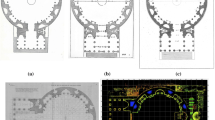Abstract
This study investigates the traditional religious architecture through the examination of Armenian Khachkar motifs at Varagavank Monastery in Van, Turkey. “Khachkar” is pivotal within Armenian religious architecture, denoting a minor architectural style and symbolising “cross-stone.” The study employs a parametric identification method to extract the fundamental unit of Khachkar motifs and develop a model to explore various variations. By utilising a mathematical analysis, the research showcases the practicality of this approach in facilitating diverse transformations within intricate designs. The study offers a comprehensive analysis of the built heritage found in Armenian religious architecture, enhancing the understanding and appreciation of these cultural artefacts. The findings of this study on Khachkars make valuable contributions to architectural research and deepen our comprehension of their significance in Armenian religious art.















Similar content being viewed by others
References
Abdullahi, Y. and Embi, M. R. B. (2013). Evolution of Islamic geometric patterns. Frontiers of Architectural Research 2(2): 243-251.
Agirbas, A. (2020). Algorithmic decomposition of geometric Islamic patterns: a case study with star polygon design in the tombstones of Ahlat. Nexus Network Journal 22: 113–137.
Alaçam, S., Güzelci, O. Z., Gürer, E. and Bacınoğlu, S. Z. (2017). Reconnoitring computational potentials of the vault-like forms: Thinking aloud on muqarnas tectonics. International Journal of Architectural Computing 15(4): 285-303.
Alani, M. W. H. (2018). Computational investigation of the morphological design dimensions of historic hexagonal-based Islamic geometric patterns. PhD Thesis, Clemson University.
Alani, M. W. and Barrios, C. R. (2015). A parametric description for metamorphosis of Islamic geometric patterns. In Proceedings of the 20th International Conference of the Association for Computer-Aided Architectural Design Research in Asia CAADRIA (pp. 20–22).
Alani, M. and Alaçam, S. (2023). Beyond Flat Surfaces Parametrıc Derıvatıons of Hıstorıcal Islamıc Geometrıc Desıgns. Architecture and Planning Journal (APJ), 28(3), 30.
Albert, F., Gomis, J. M., Blasco, J., Valiente, J. M. and Aleixos, N. (2015). A new method to analyse mosaics based on Symmetry Group theory applied to Islamic Geometric Patterns. Computer Vision and Image Understanding, 130, 54-70.
Arik, M. and M. Sancak, (2007). Turkish-Islamic Art and Penrose Tilings. Balkan Physics Letters 15 (3): 84–95.
Bonner, J. (2003). Three traditions of self-similarity in fourteenth and fifteenth century Islamic geometric ornament. In Meeting Alhambra, ISAMA-BRIDGES Conference Proceedings (pp. 1–12).
Cenani, S. and Çağdas, G. (2007). A shape grammar study: form generation with geometric Islamic patterns. In Generative Art Conference (Vol. 10, p. 2).
Demiriz, Y. (2017). İslam Sanatında Geometrik Süsleme: Bir Envanter Denemesi. HayalPerest Kitap.
Donabédian, P. (2018). Can we call" khachkar" the Sudak cross-stones?
Erbaş, S. K. (2013). Mimaride Parametrik Tasarım ve Eğitimi. Eğitim ve Öğretim Araştırmaları Dergisi, 14 (4): 119-124
Georgopoulos, A. (2018). CIPA’s perpectives on cultural heritage. Communications in Computer and Information Science, pp. 215–245
Hamzaoğlu, B. and Özkar, M. (2018). Zanaatın Sayısallaştırılması: Selçuklu Dönemi Oyma Taş Desenlerin Sayısal Üretim Araçları ile Yapımı. International Art Craft Space Congress.
Kaplan, M. and Cohen, E. (2003). Computer-Generated Celtic Design. Eurographics Symposium on Rendering, 3, 9-19.
Karaca, Y. and Kızgın, E. E. (2021). Yedikilise Manastırı (Varagavank) Girişleri ve Süsleme Özellikleri Üzerine Bir Değerlendirme. Uluslararası Sanat ve Estetik Dergisi. (6), 127-174.
Khamjane, A. and Benslimane, R. (2018). A Computerized Method for Generating Islamic Star Patterns. Computer-Aided Design, 97, 15-26.
Kızgın, E. E. (2018). Van Yedikilise Manastırı (Varagavank) Saint Croix Kilisesi Haçkar Örnekleri. Yüzüncü Yıl Üniversitesi Sosyal Bilimler Enstitüsü Dergisi, (40), 319-348.
Kolarevic, B. (Ed.). (2004). Architecture in the Digital Age: Design and Manufacturing. Taylor & Francis.
Lionel, M. and Philip, S. (1974). Geometry of Environment: An Introduction to Spatial Organisation in Design.
Mkhitaryan, N. E. and Avedian, S. A. (2022). Architecture Stages and Features of Compositional Formations of Khachkars. Journal of Architectural and Engineering Research, 2, pp. 52–58.
Naserabad, A. A. and Ghanbaran, A. (2023). Presenting a Method to Generate Existing and Novel Girihs (Islamic Geometric Patterns) for All Systems and Families Based on 7-Fold Patterns. Computer-Aided Design, 154, 103418.
Necipoğlu, G. (1996). The Topkapi Scroll: Geometry and Ornament in Islamic Architecture. Getty Publications.
Ocón, D. (2021). Digitalising endangered cultural heritage in Southeast Asian cities: preserving or replacing? International Journal of Heritage Studies, 27 (10), 975–990.
Oxman, R. and Oxman, R. (2014). Theories of the Digital in Architecture. Abingdon: Routledge.
Ögel, S. (1987). Anadolu Selçukluları’nın Taş Tezyinatı. Türk Tarih Kurumu Yayınları, Ankara, s.123.
Pérez-Gómez, R. (1987). The four regular mosaics missing in the Alhambra. Computers & Mathematics with Applications, 14 (2), 133–137.
Rhino, Rhinoceros® Design, Model, Present, Analyze, Realize, (2022). https://www.rhino3d.com/mcneel/about/.
Rigby, J. (2005). A Turkish Interlacing Pattern and the Golden Ratio: Whirling Dervishes and a Geometry Lecture in Konya. Mathematics in School 34 (1): 16–24.
Robinson, T. (2007). Extended Pasting Scheme for Kolam Pattern Generation. Forma, 22(1), 55–64.
Sayed, Z., Ugail, H., Palmer, I., Purdy, J. and Reeve, C. (2015). Parameterized shape grammar for generating n-fold Islamic geometric motifs. In 2015 International Conference on Cyberworlds (CW) (pp. 79–85). IEEE.
Seppälä, S. (2021). The Struggle for Memory: The Khachkar Field of Julfa and Other Armenian Sacred Spaces in Azerbaijan. Review of Ecumenical Studies Sibiu, 13(2), 185–213.
Stevenson, A. (2010). Oxford Dictionary of English. Oxford University Press, USA.
Taylor, L. D. (2009). Decorative Knotting Using Trigonometric Parametrizations. In Visual Mathematics (No. 42, pp. 0–0). Mathematical Institute SASA.
Waring, T. M. (2012). Sequential encoding of Tamil kolam patterns. Forma, 27, 83–92.
Wilson, E. (1988). Islamic Designs. London: The British Museum Press.
Yanagisawa, K. and Nagata, S. (2007). Fundamental Study on Design System of Kolam Pattern. Forma, 22(1), 31-46.
Yıldız, E. (2017). Van Çarpanak Adası Ktouts-Ktuc Manastırı Saint Jean Baptiste Kilisesi Kubbe Kasnağı Plastik Süslemeleri. Yüzüncü Yıl Üniversitesi Sosyal Bilimler Enstitüsü Dergisi, (34).
Author information
Authors and Affiliations
Corresponding author
Ethics declarations
Conflict of interest
The authors are working on a doctoral thesis as part of the study's scope.
Additional information
Publisher's Note
Springer Nature remains neutral with regard to jurisdictional claims in published maps and institutional affiliations.
About this article
Cite this article
Bayer, S., Çakici Alp, N. Varagavank Monastery’s Khachkar Motifs: Understanding Production Through Parametric Methods. Nexus Netw J 26, 257–274 (2024). https://doi.org/10.1007/s00004-023-00753-w
Accepted:
Published:
Issue Date:
DOI: https://doi.org/10.1007/s00004-023-00753-w




